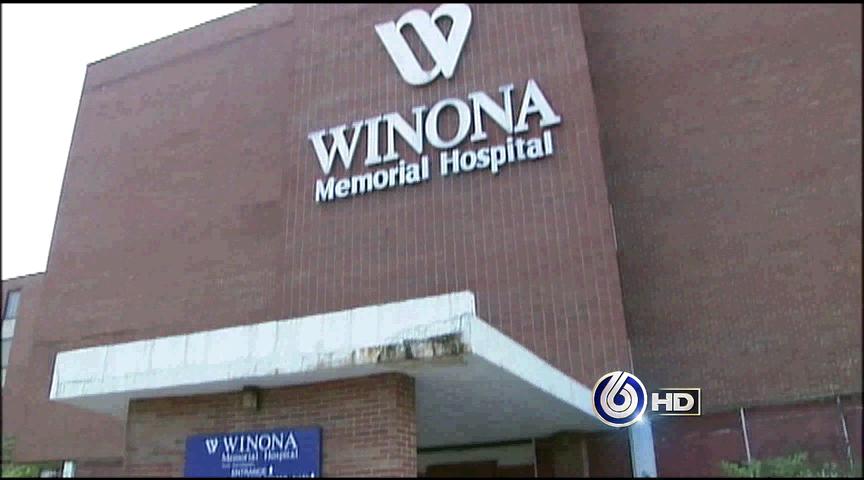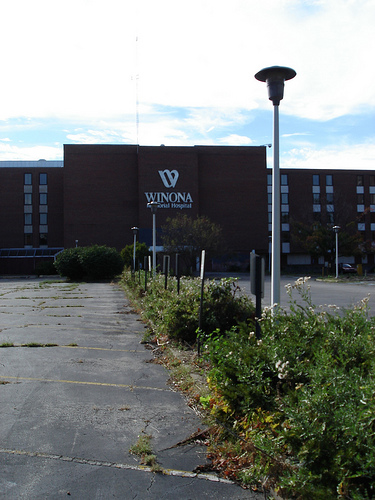
Winona Memorial Hospital. 1956 – 2012.
Winona Memorial Hospital died on 10 October as demolition began. Vacant for seven years, the deceased was a short-term care facility with 317 licensed beds. The cause of death was reported in a statement released 2 September 2004 by board chair Robert E. Mehl, MD, was lack of operating funds. The autopsy will find the cause of death was not recognizing a changing industry, financial mismanagement, and the lack of a clear mission and vision.
“Despite our loss of investment, we are proud of our attempt to save the hospital, and equally proud and thankful for the support of the hospital staff and those in the community who worked hard to keep Winona Hospital’s doors open and to offer excellent medical care,” Board Chiar, Dr. Robert Mehl
Mehl led a group of physician investors who assumed responsibility of the patient at a time when it was struggling under the weight of mismanagement, lack of direction, a changing healthcare environment and industry, and lack of focus. Up until the end, a consistent murmur of hope could be heard.
Winona Memorial Hospital was born in 1956. Founded by Joseph Walther, M.D. as Winona Memorial Clinic, Winona was the first private, for-profit hospital in Indianapolis. In a constant battle with the larger health systems for market share, the small Clinic grew into a 280 bed facility in 1966. Over the years, physicians found Winona actively meeting the needs of its neighborhood, offering a series of specialty services – always with patient care at the forefront.
Through the years, Winona’s beds filled with short-term surgery, cosmetic surgical patients, wound care, psychiatry, and weight loss programs. Like parents of a child growing up, physician and administrative leadership were constantly trying to determine what Winona should be when it grew up.
The size, scope, and desire to remain financially profitable led to unique, boutique clinics evolving within a system that could barely support them; yet, drew specialty audiences. The strategy was to build a series of boutique services that could be accessed easily on site. One of its greatest successes – financially and clinically, was its surgical weight loss program. Built at the beginning of surgical weight loss’ resurgence in the 1990’s, the program boasted outstanding outcomes and a patient base from multiple states.
The bariatric weight loss program’s success was the catalyst for larger systems in the community to take note. One health system recruited the surgeons and senior staff of the program to leave the financially strapped, low income neighborhood of Winona and move to a suburban hospital whose community resided on one of the fastest growing and richest counties in the nation. Winona’s response was in the form of legal action. This was endemic of its organizational culture and lack for leadership direction.
Tenet Health Care Corporation purchased the facility in the mid 1980’s from Dr. Walther. During this period, the leadership changed the name and scope of the institution. The result was a new name, brand, and expanded clincial service, complete with cardiac services. The birth of Midwest Medical Center came with lackluster fanfare, physician recruitment, great hopes, and a new branding. For those of us in Indianapolis, the iconic hospital on the main thoroughfare in the city, referred to the hospital as “the old Winona.” Soon, the new branding fell and the Winona of yesteryear reappeared.
Quickly, new owners found the small specialty hospital would not garner financial rewards and Winona was searching for new owners. After three years of hosting a for sale sign, Leland Medical Centers of Plano, Texas purchased Winona in 2002. Beginning in 2003, Dr. Walther’s clinic went through financial restructuring, lay-offs, and program elimination. Two years after the purchase, Leland filed for bankruptcy leaving Winona with $6.3 million in unpaid bills, and up to $10 million owed to more than 600 creditors.
The group of eleven physicians was the last in a litany of Winona’s owners. At the point the physician groups assumed control, local Indianapolis business writers penned Winona was “financially distressed” as a resulting from debts reaching into the millions. The cause was seen as a short-term cash flow problem and anticipated real estate refinancing had not occurred.
Life for Winona had become so bad, that Indianapolis Power & Light Company cut off electricity to ancillary buildings on the hospital campus as a result of being owed $400,000. All the lights were turned off soon thereafter. Once patients were released or transferred, the hospital owners, leadership, and staff simply walked out of the building. Left behind were patient charts, records, equipment, medication, and all the resources required to operate a healthcare facility. For seven years, patient rooms and surgical suites that brought life into the world and healing to the sick were replaced with dirt, theft, homeless, and the blight that comes from neglect.
The owner an caregivers simply turned off the remaining lights, locked the doors, and walked away.
 Pristine hallways and sterile environments were now filled with weeds, graffiti and inhabitants reflecting the urban blight of its surroundings. The doors that brought the upper north side community hope were an eyesore and a scab on an economically depressed corridor of the community. The drugs, equipment, and documentation were now in the hands of homeless, theifs, and individuals who found a new use for once life-saving resources.
Pristine hallways and sterile environments were now filled with weeds, graffiti and inhabitants reflecting the urban blight of its surroundings. The doors that brought the upper north side community hope were an eyesore and a scab on an economically depressed corridor of the community. The drugs, equipment, and documentation were now in the hands of homeless, theifs, and individuals who found a new use for once life-saving resources.
In a strange bit of irony, the lack of focus, direction, and attention to the environment that led to the death of Winona is becoming the lifeblood of its next chapter.
A few blocks south of the Winona space is The Indianapolis Children’s Museum. Heralded as one of the largest and leading children’s museums in the world, The Children’s Museum now owns some of the property and is collaborating with the City of Indianapolis to lead redevelopment of the space. Green space, hosing, retail, and area for Museum development projects will transform this vacant hallways and overgrown campus area into a focal point for the neighborhood. The pending agreement with the City to redevelop the area will be led by leadership cognizant of its neighbors, the need for direction, focus, planning, and financially sound judgment.
More importantly, the space inhabited by a clinic named for Dr. Walther’s mother and dedicated to healing will be led by the voices and visions of children.
The patient died and is in the process of burial. May the memories of those who found hope at Winona, those who shared their gifts of healing, and those who fought valiantly for its health, be for a blessing.
Leave a Reply